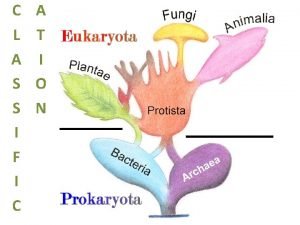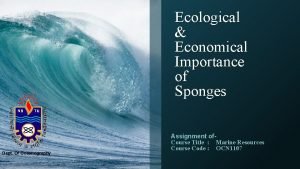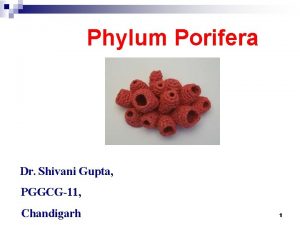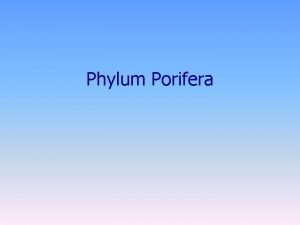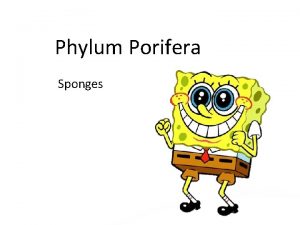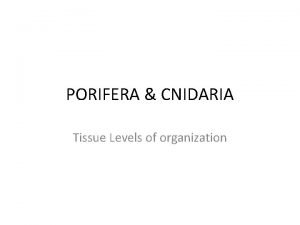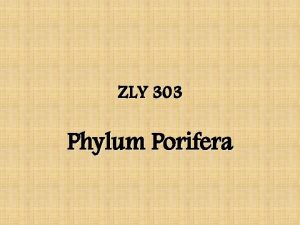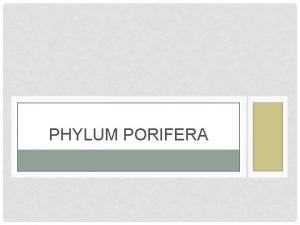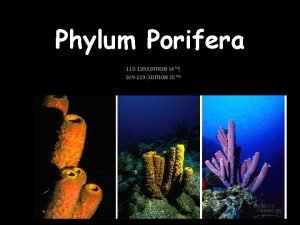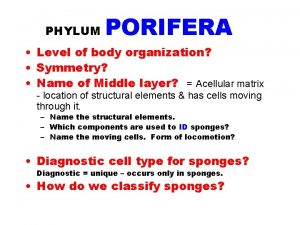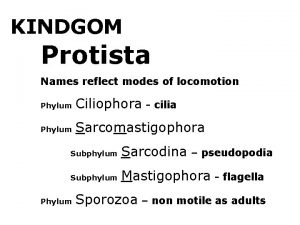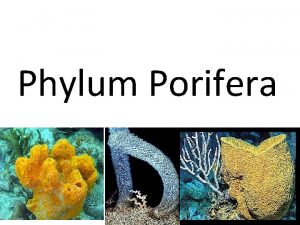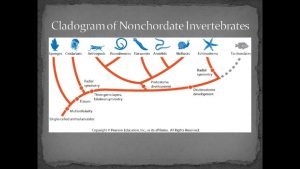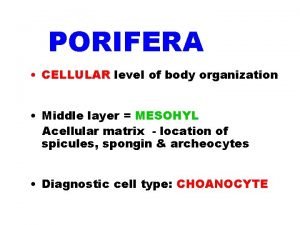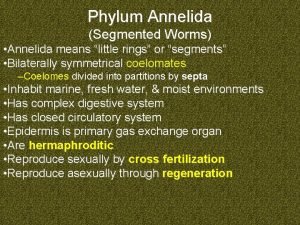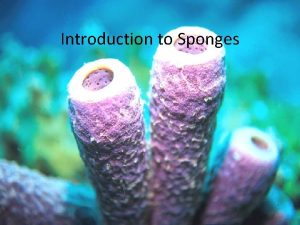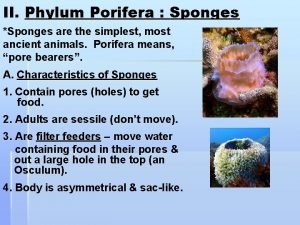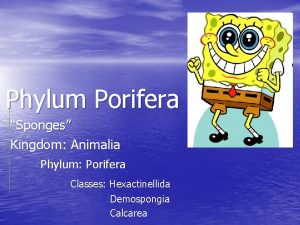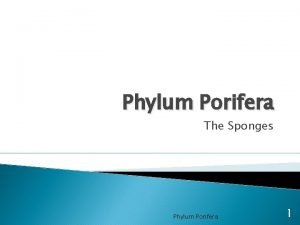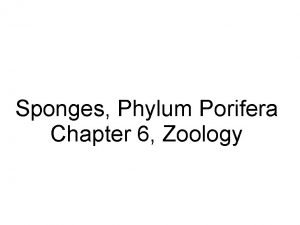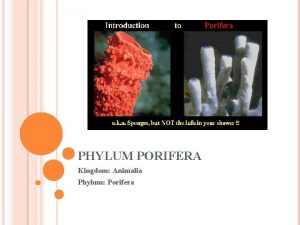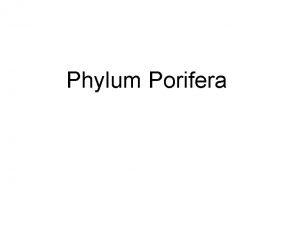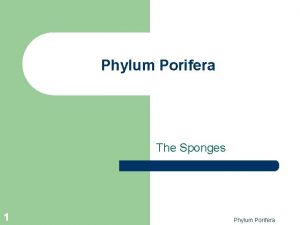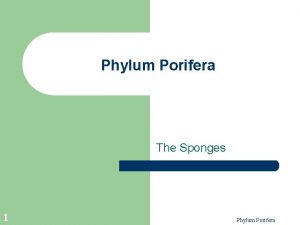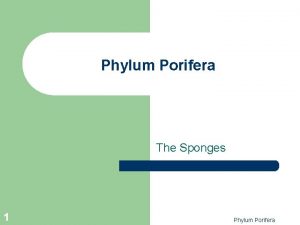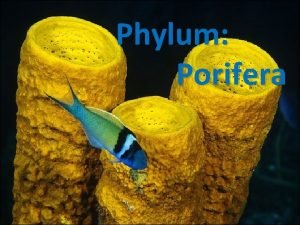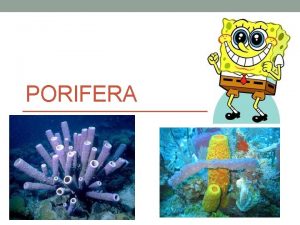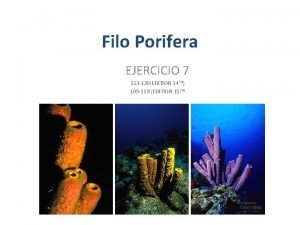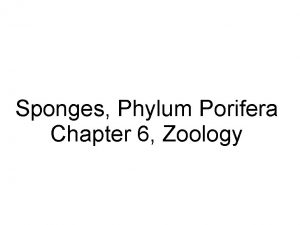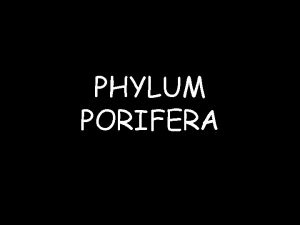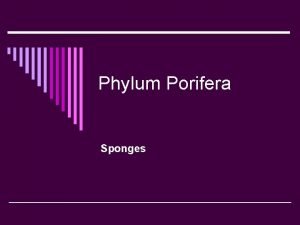Phylum Porifera 113 120EDITION 14 TH 109 119



















- Slides: 19

Phylum Porifera 113 -120(EDITION 14 TH) 109 -119 (EDITION 15 TH)

Goals for today • Learn to recognized the Phylum Porifera from other animals • Learn the main ‘diagnostic’ characteristics, structures, and their function • Learn about some sponges biology

Phylum Porifera • Most are marine • Freshwater species are found in ponds and streams • Solitary or colonial • Adults are sessile and benthic

Porifera = "pore bearer" These are the simplest metazoans (multi cellular organisms) Protostomia Bilateria Radiata Parazoa Eumetazoa Ancestral colonial choanoflagellate Deuterostomia Ecdysozoa Lophotrochozoa Cnidaria and Ctenophora Porifera Parazoa • No organs, no mouth, no nervous, digestive or circulatory system, only rudimentary nervous integrations. • Little or no tissue organization • No germ layers (so neither diploor triploblastic) • Two thin layers of cells (Epidermis and Endodermis) • Some have radial symmetry some do not

Phylum Porifera Main characteristics of sponges are: • Internal skeletons of spicules or organic fibers (spongin). • Pores and canal systems (asconoid, siconoid, and leuconoid) • Internal cavity= spongocoel that opens to an osculum

Phylum Porifera • Flagellated sponge feeding cells= choanocytes. • By cooperatively moving their flagella, choanocytes generate a flow of water through the sponges pores, into the spongocoel, and out through the osculum.

Phylum Porifera Feeding Behavior http: //www. youtube. com/watch? feature=player_embedded&v=Rm. PTM 965 -1 c

Porifera: Classification Classes: Calcarea: • Spicules of calcium carbonate • Needle-shaped or 3 -4 rayed spicules • Canal systems asconoid, siconoid, or leuconoid • All marine Hexactinellida (Glass sponges): • 3 D, six-rayed spicules • Siliceous spicules (Si. O 2)forming a network • Body often cylindrical or funnel-shaped. • Canal systems siconoid or leuconoid • All marine, and most deep water spp. Demospongiae: • Siliceous spicules (not six-rayed), spongin or both • Canal system leuconoid • One family freshwater, most marine • Most sponges belong to this class

Porifera: Your Tasks Exercise 7: – Phylum: Porifera (sponges) – Class Calcarea • Genus: Sycon (=Scypha, Grantia)

Porifera: Sycon 2. Take a slide from your box with (Sycon, Grantia, or Scypha) this is a cross section cut: identify the incurrent canal, spongocoel, and the radial canal Water enters the incurrent canals and passes through minute openings called? ______ Check your book for answers!

Porifera: Sycon What is the apopyle? Check your book!

Porifera: Sycon 3. Take a slide from your box with (Sycon, Grantia, or Scypha) in a longitudinal cross section you would see the following specialized cells: what are their function?

Porifera: Your Tasks Phylum: Porifera (sponges) – Class Calcarea • Genus: Leucosolenia has an asconoide canal system

Porifera: Leucosolenia 1. Try to find the osculum. This is a colonial species of tubular individuals in various stages of development osculum

Porifera: Leucosolenia 2. Look into the microscope a slide of Leucosolenia body and its spicules

Porifera: Your Tasks – Phylum: Porifera – Class Hexactinellida (Glass sponges) • Genus: Euplectella

Porifera: Your Tasks 1. Look at preserved specimens of Euplectella Some species of Euplectella have a commensal relationship with a shrimp species. A young male and female shrimp enter the central cavity and live there. As they grow they become too large to escape through the sieve-like covering of the osulum, and so spend their entire life inside the sponge.

Porifera: Your Tasks – Phylum: Porifera (sponges) – Class Demospongiae • Gemmulas (asexual reproductive structures) -Gemmules are asexual reproductive structures of freshwater sponges and some marine sponges of the class Demospongiae. -Made up of amoebocytes surrounded by a layer of spicules and can survive conditions that would kill adult sponges. What is their function in reproduction?

Important Links Porifera http: //faculty. uml. edu/rhochberg/hochberglab/Courses/Invert. Zool/Quiz es/Porifera%20 Quiz%201. html http: //www. bumblebee. org/invertebrates/Porifera. htm http: //bioweb. uwlax. edu/zoolab/Table-Of-Contents. htm
 Features of porifera
Features of porifera Economic importance of sponge
Economic importance of sponge Phylum porifera
Phylum porifera General characters of porifera
General characters of porifera Body plan of porifera
Body plan of porifera Porifera and cnidaria
Porifera and cnidaria Ascon
Ascon Phylum porifera questions
Phylum porifera questions Leucosolenia slide
Leucosolenia slide Porifera body symmetry
Porifera body symmetry Phylum
Phylum Ascon leucon sycon
Ascon leucon sycon Enchinoderma
Enchinoderma Level of organization porifera
Level of organization porifera Annelus means small ring
Annelus means small ring Phylum porifera introduction
Phylum porifera introduction Sponges characteristics
Sponges characteristics Phylum porifera
Phylum porifera Mesoglea
Mesoglea Sponges types
Sponges types
